NEBRASKA MUNICIPAL REVIEW
NEBRASKA MUNICIPAL REVIEW

Chadron water tank repainted to reflect community history
Creighton breaks ground on new fire hall
Cozad celebrates 150 years
Official Publication of the League of Nebraska Municipalities
FEBRUARY 2024

NEBRASKA MUNICIPAL REVIEW
Contents
FEBRUARY 2024
No. 1,186
ISSN 0028–1906
About the Cover:
The hilltop water tank south of Chadron recieved a fresh coat of paint and brand new look last summer thanks to a passionate group of community members. Photo provided by Gabby Michna/ Chadron Chamber of Commerce
4
Larger Cities Legislative Committee
Seth Sorensen, City Manager, Alliance
Tobias Tempelmeyer, City Administrator/General Manager, Beatrice
Rusty Hike, Mayor, Bellevue
Jim Ristow, City Administrator, Bellevue
Mindy Rump, Mayor, Blair
Phil Green, City Administrator, Blair
Desirae Solomon, City Attorney, Blair
Miles Bannon, Council Member, Chadron
Tom Menke, City Manager, Chadron
Jim Bulkley, Mayor, Columbus
Tara Vasicek, City Administrator, Columbus
Dave Bauer, Mayor Crete
Tom Ourada, City Administrator, Crete
Joey Spellerberg, Mayor, Fremont
Jody Sanders, City Administrator, Fremont
Kent Ewing, Mayor, Gering
Laura McAloon, City Administrator, Grand Island
Mike Evans, Mayor, Gretna
Paula Dennison, City Administrator, Gretna
Corey Stutte, Mayor, Hastings
Shawn Metcalf, City Administrator, Hastings
James Liffrig, Mayor, Holdrege
The President’s Message by Gibbon Mayor Deb VanMatre, League President – League and NACO hold joint press conference to release poll results relating to property tax relief
Feels like home: Nebraska Vietnam Veterans Memorial in Papillion welcomes Vietnam-era Huey to serve as one of the focal points of the exhibit
Under the open sky: Chadron water tank repainted to reflect history of community
Growing together: Mayor Joey Spellerberg delivers State of City address in Fremont
Breaking new ground in Creighton
Build connections at NLC’s Congressional City Conference in March
USDA Rural Development: Smell the roses – Single Family Housing Repair Loans and grants
A year to remember in Cozad
Recycling Council seeks input from municipalities on waste reduction
FEMA listens to feedback, reforms disaster assistance program
LARM – If you see something, say something
Fischer, Ricketts announce $15.3 million investment in airport infrastructure statewide
Exploring AI applications in city government: The promise and the risks
The Legal Corner by Jeremiah J. Perkins, Cline Williams Wright Johnson & Oldfather, L.L.P. - Abandoned and neglected property management methods: the Vacant Property Registration Act
Chris Rector, City Administrator, Holdrege
Stan Clouse, Mayor, Kearney
Brenda Jensen City Manager, Kearney
Doug Kindig, Mayor, La Vista
Pam Buethe, Clerk, La Vista
John Fagot, Mayor, Lexington
Joe Pepplitsch, City Manager, Lexington
Margaret Blatchford, Assistant City Attorney, Lincoln
Amanda Barker, Advisor to the Mayor, Lincoln
Linda Taylor, Mayor, McCook
Nate Schneider, City Manager, McCook
Bryan Bequette, Mayor, Nebraska City
Perry Mader, City Administrator, Nebraska City
Josh Moenning, Mayor, Norfolk
Andrew Colvin, City Administrator, Norfolk
Dani Myers-Noelle, City Attorney, Norfolk
Brandon Kelliher, Mayor, North Platte
Layne Groseth, City Admin./Utilities Manager, North Platte
Steve Krajewski, Mayor, Ogallala
Kevin Wilkins, City Manager, Ogallala
Thomas Warren, Chief of Staff, Omaha
David Black, Mayor, Papillion
Amber Powers, City Administrator, Papillion
Smaller Cities Legislative Committee
Jessica Quady, City Administrator, Ashland
Marlin Seeman, Mayor, Aurora
Eric Melcher, City Administrator, Aurora
Chris Anderson, City Administrator, Central City
Nikki Schwanz, City Administrator, Cozad
Andrew Lee, Admin./Clerk/Treasurer, Curtis
Alan Michl, Chairperson, Exeter
Becky Erdkamp, Clerk/Treasurer, Exeter
Kyle Svec, City Administrator, Geneva
Deb VanMatre, Mayor, Gibbon
Matt Smallcomb, City Administrator, Gibbon
Gary Greer, City Administrator, Gothenburg
Douglas Huber, Mayor, Hebron
Jana
Sandra
David
Mandy
Mike
Nancy Bryan, Clerk/Treasurer, Stromsburg
Sandra Foote, Council Member, Superior
R. Paul Lambert, Mayor, Plattsmouth
Emily Bausch, City Administrator, Plattsmouth
Don Groesser, Mayor, Ralston
Brian Kavanaugh, Council Member, Ralston
Rick Hoppe, City Administrator, Ralston
William De Roos, City Administrator, Schuyler
Jeanne McKerrigan, Mayor, Scottsbluff
Jordan Colwell, Vice Mayor, Scottsbluff
Kevin Spencer, City Manager/Police Chief, Scottsbluff
Joshua Eickmeier, Mayor, Seward
Greg Butcher, City Administrator, Seward
Roger Gallaway, Mayor, Sidney
David Scott, City Manager, Sidney
Carol Schuldt, Council Member, South Sioux City
Lance Hedquist, City Administrator, South Sioux City
Cale Giese, Mayor, Wayne
Jill Brodersen, Council President, Wayne
Wes Blecke, City Administrator, Wayne
Barry Redfern, Mayor, York
Dr. Sue Crawford, City Administrator, York
Jeff Hofaker, City Administrator, Sutton
Jessica Meyer, City Administrator, Syracuse
Kyle Arganbright, Mayor, Valentine
Melissa Harrell, City Administrator, Wahoo
Desiree Soloman, City Attorney, Waterloo
Stephanie Fisher, City Administrator, Waverly
Tom Goulette, City Administrator/Utility Superintendent, West Point
Randy Woldt, Utilities Superintendent, Wisner
18
Professional Directory 6
13 14 22 20 26 27 24 10 12 16
Tietjen, Clerk, Hebron
Kelly Oelke, City Administrator, Hickman
Janine K. Schmidt, CMC/Treasurer, Morrill
Schendt, Clerk/Treasurer, Nelson
Russell, Director of Government Affairs, NMPP Energy
Hansen, Government Affairs Liason, NMPP Energy
Benjamin
Sandy Kruml, Clerk/Treasurer, Ord
Benton, City Administrator/Clerk, Randolph
Feeken, Council Member, St. Paul
28 30
Executive Board 2023-2024
President Deb VanMatre Mayor, Gibbon
President-Elect Marlin Seeman Mayor, Aurora
Vice President Bryan Bequette Mayor, Nebraska City
Past President Paul Lambert Mayor, Plattsmouth
Directors
Jean Stothert Mayor, Omaha
Leirion Gaylor
Baird Mayor, Lincoln
Julie A. Deepe Mayor, Deshler
Catherine-Jo
Mills Village Chair, Ansley
Joey Spellerberg Mayor, Fremont
Jordan Colwell Vice Mayor, Scottsbluff
Josh Moenning Mayor, Norfolk
Jeff Hofaker City Administrator, Sutton
Janine K. Schmidt CMC/Treasurer, Morrill
Layne Groseth City Administrator/Utilities Manager, North Platte
Affiliated Sections
City Managers Amber Powers Papillion
Clerks Elizabeth Butler Omaha
Municipal Brandi Kloepping
Accounting Cozad
& Finance
Fire Chiefs Dennis Thompson North Platte
Utilities Duane Hoffman Oxford
League Staff
L. Lynn Rex Executive Director
Christy Abraham Legal Counsel
Lash Chaffin Utilities Section Director
Cherie DeFreece Administrative Assistant/ Membership Services Assistant
Brenda Henning Membership Services Assistant
Ethan Nguyen LNM/LARM Information Technology Manager
Jackson Sash Utilities Field Representative/ Training Coordinator
Shirley Riley Membership Services Director
Ashley Wolfe Marketing/Communications Director
LARM Staff
Dave Bos Executive Director
Tracy Juranek Assistant Executive Director, Customer Service Specialist
Diane Becker Communications/Marketing Director
Kyla Brockevelt Executive Administrative Assistant
Drew Cook Customer Service Specialist
John Hobbs Loss Control Specialist
James Kelley Loss Control Specialist
Fred Wiebelhaus Loss Control/Claims Manager
NLC Congressional City Conference
Nebraska Municipal Clerks Institute and Academy
CALENDAR
March 9-13, Washington D.C.
March 18-22, Columbus Municipal Accounting and Finance Conference
Municipal Legal Calendar
(All statute citations to Revised Statutes of Nebraska)
Within 10 days following meeting or before next meeting
(whichever is sooner)
June 12-14, Cornhusker Marriott Hotel, Lincoln APRIL 2024
CITIES OF THE FIRST CLASS
Clerk to have minutes available for public inspection. (84-1413)
Within 15 days of Passage Clerk publishes ordinances passed. (16-405)
Within 30 days following
Council meeting
End of each quarter
Semiannually
Within 20 days after end of month
April 30
Clerk publishes official proceedings of meeting. (19-1102)
Report from depository banks. (16-714)
Mayor and Council publish a statement of receipts and expenditures (16-722)
Treasurer files monthly financial report. (16-318)
Liquor licenses (other than Class C) expire unless renewed. (53-124)
* * Clerk must prepare agenda prior to next Council meeting. (84-1411)
On or before May 1
Within 10 days following meeting or before next meeting
(whichever is sooner)
Annual report to governing bodies regarding redevelopment projects (TIF) (18-2117.02)
CITIES OF THE SECOND CLASS
Clerk to have minutes available for public inspection. (84-1413)
Within 15 days of Passage Clerk publishes or posts ordinances passed. (17-613)
Within 30 days following
Council meeting
Within 20 days after end of month
April 30
**
On or before May 1
Within 10 days following meeting or before next meeting (whichever is sooner)
Clerk publishes official proceedings of meeting. (19-1102)
Treasurer files monthly financial report. (17-606)
Liquor licenses (other than Class C) expire unless renewed. (53-124)
Clerk must prepare agenda prior to next Council meeting. (84-1411)
Annual report to governing bodies regarding redevelopment projects (TIF) (18-2117.02)
VILLAGES
Clerk to have minutes available for public inspection. (84-1413)
Within 15 days of Passage Clerk publishes or posts ordinances passed. (17-613)
Within 30 days following Council meeting
Within 20 days after end of month
April 30
**
On or before May 1
Clerk publishes official proceedings of meeting. (19-1102)
Treasurer files monthly financial report. (17-606)
Liquor licenses (other than Class C) expire unless renewed. (53-124)
Clerk must prepare agenda prior to next Board meeting (84-1411)
Annual report to governing bodies regarding redevelopment projects (TIF) (18-2117.02)
Nebraska Municipal Review Editor and Advertising Sales: Ashley Wolfe, 402-476-2829 or ashleyw@lonm.org
The NEBRASKA MUNICIPAL REVIEW is the official publication of the League of Nebraska Municipalities, an association of the cities and villages of Nebraska, published at 1335 L St., Lincoln, Nebraska 68508 — Telephone 402-476-2829; FAX 402-476-7052; Website: www.lonm.org. Periodicals postage paid at Lincoln, Nebraska. Views of contributors, solicited or unsolicited, are their own and not to be construed as having the endorsement of the League unless specifically and explicitly stated by the publisher
The NEBRASKA MUNICIPAL REVIEW is a nonprofit publication administered and supervised by the League of Nebraska Municipalities. All revenue derived from the publication is used by the association to defray publication costs.
The NEBRASKA MUNICIPAL REVIEW is published monthly. Subscription rates are $5 per single copy — $50 plus tax for 12 issues.
POSTMASTER: Send address changes to NEBRASKA MUNICIPAL REVIEW, 1335 L Street, Lincoln, Nebraska 68508.

“GComments from
League and NACO hold joint press conference to release poll results relating to property tax relief
BY DEB VANMATRE, MAYOR OF GIBBON, LEAGUE PRESIDENT
ood morning. My name is Deb VanMatre. I am the Mayor of Gibbon and President of the League of Nebraska Municipalities. It is important to emphasize that the League Executive Board and NACO Board of Directors support the Governor’s overall objective to provide property tax relief with the use of state sources of revenue. However, the League Board and NACO Board defer to the Governor and the Legislature to determine which state sources of revenue should be used to provide additional property tax relief to Nebraskans.
The statewide poll commissioned by the League and NACO underscores the need for more property tax relief. The poll also indicates that an overwhelming number of Nebraska voters across the political spectrum support using various state sources of revenue to provide additional property tax relief and help local governments maintain essential services. Having served as a local elected official for over 23 years, I was not surprised by the extremely high percentage of Nebraska voters who regard as important our municipal and county investments in infrastructure, emergency services, public safety services as well as our libraries, parks, and recreation centers.
As I previously stated, the League and NACO both support the Governor’s overall objective to provide additional property tax relief to Nebraskans. However, it is important to recognize the significant tax relief efforts achieved last year by the Legislature …under the leadership of Revenue Committee Chair Lou Ann Linehan and Governor Pillen …with passage of proposals committing about one billion dollars in property tax relief. However, more property tax relief is needed to address the decades and decades of property tax exemptions granted by previous Legislatures which dramatically narrowed the property tax base on which local governments rely to fund essential services.
Most of the exemptions were necessary so our business
Please review the results of the poll commissioned by the League and NACO which shows an overwhelming percentage of Nebraska voters support using various state sources of revenue to provide additional property tax relief!
As summarized in "The Bottom Line" of the poll, three-fifths of voters oppose the proposal to cap local governments; an overwhelming percentage of voters also support providing spending flexibility to local governments.
and ag sectors could compete with surrounding states. Each exemption was a tax shift to the remaining property taxpayers. However, unlike other states, the Nebraska Legislature historically did not reimburse local governments for the revenue lost due to the increasingly narrowed property tax base, resulting in fewer and fewer Nebraskans paying more and more. Except for school districts, the totally inadequate reimbursement to other local governments to offset even some of the lost property tax revenue was repeatedly cut and eliminated in 2011 to meet the Legislature’s budget cutting goals at the time.
Except for schools, commitments by previous Legislatures to replace the lost ‘state aid’ to municipalities, counties and other local governments never happened …but the unfunded
4 NEBRASKA MUNICIPAL REVIEW
MESSAGE
PRESIDENT’S
news conference
excerpts from the report on page 31 or read the entire report at: https://bit.ly/49jG56y
See



“The League and NACO Board of Directors support the Governor’s overall objective to provide property tax relief with the use of state sources of revenue. [Both organizations] defer to the Governor and the Legislature to determine which state sources of revenue should be used to provide additional property tax relief to Nebraskans.”
mandates continue. Recommendations in Tax Reports commissioned by the Legislature in 1988, 2007 and 2013 stated local governments in Nebraska received lower levels of state revenue sharing than local governments in other states in the region or nation. In recent years, under the leadership of Senator Linehan, the Legislature has provided significant property tax relief, especially to school districts. However, as Senator Linehan and the Governor have stated, MORE NEEDS TO BE DONE.
I will conclude my remarks by expressing the League’s appreciation for the ongoing dedication of the Revenue Committee and the Governor’s overall objective to now commit another one billion dollars from state sources of revenue to provide more property tax relief. Thank you.”
See Poll / page 31 for more on the report

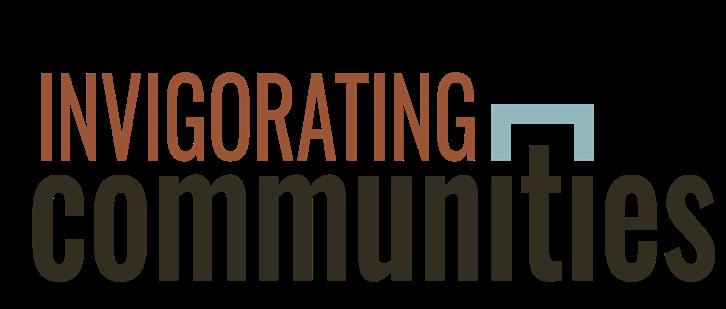





5 FEBRUARY
2024
ENGINEERING ■ SURVEYING ■ PLANNING ■ DESIGN
Deb VanMatre, Mayor of Gibbon and League of Nebraska Municipalities President, speaks at the press conference held on Feb. 15 in the Capitol Rotunda. President Deb also was joined by Mark Schoenrock, Jefferson County Commissioner and NACO Board Member, along with League Executive Director, Lynn Rex, and NACO Executive Director, Jon Cannon. Photos by Ashley Wolfe
Scan to learn more or visit snyder-associates.com
Leading a successful and thriving community in our constantly changing world is no small task. Take advantage of our free online resources to help your community address these challenges.

Feels like home
Nebraska Vietnam Veterans Memorial in Papillion welcomes Vietnam-era Huey to serve as one of the focal points of the exhibit
BY ASHLEY WOLFE, MARKETING DIRECTOR, LNM
“On May 10, 1969, Crew Chief Craig Fouts received a shiny new UH-1 Huey Helo for his 21st birthday. Aircraft 68-15532 would join a small platoon of UH-1 Hueys and 0H-6A Loaches, known as Snoopy Flight, to conduct command and control operations for the 3rd Brigade 1st Cav Division. Fouts’ first impression on 532: “It is not as shiny as 918 was and is more of a dull brown color. We are going to have to paint a ‘Snoopy’ on the nose and give it some bright orange paint for the Snoopy identification colors.” When it was done, it was the only aircraft in the fleet on which Snoopy had a tail.”
-Nebraska Vietnam Veterans Memorial narrative
Jan. 31, 2024, marked an exciting milestone for the aircraft, Papillion, and the State of Nebraska. This was the day that the restored UH-1 Huey Helicopter arrived at its new home at the Nebraska Vietnam Veterans Memorial, located just south of SumTur Amphitheater.
The UH-1 Iroquis, nicknamed ‘Huey’ is remembered as the work horse and icon of the Vietnam War because of its widespread use. This helicopter, with tail No. 68-15532, flew a total of 3,180 hours in Vietnam over the course of four years.
Continued on page 8 / See Veterans

6 NEBRASKA MUNICIPAL REVIEW
Top image: The restored UH-1 Huey Helicopter passes over the Missouri River from Iowa to Nebraska while making its final journey to the site of the Nebraska Vietnam Veterans Memorial, currently under construction in Papillion. Above right: The helicopter bears the signatures of all those involved in restoring it, as well as the original crew who first flew it in the Vietnam War. Picture page at right: A collection of images from Jan. 31 showing the process of securing the helicopter at its new home. Hawkins Construction Company was a key partner in ensuring the move went smoothly. Photos shared courtesy of City of Papillion.
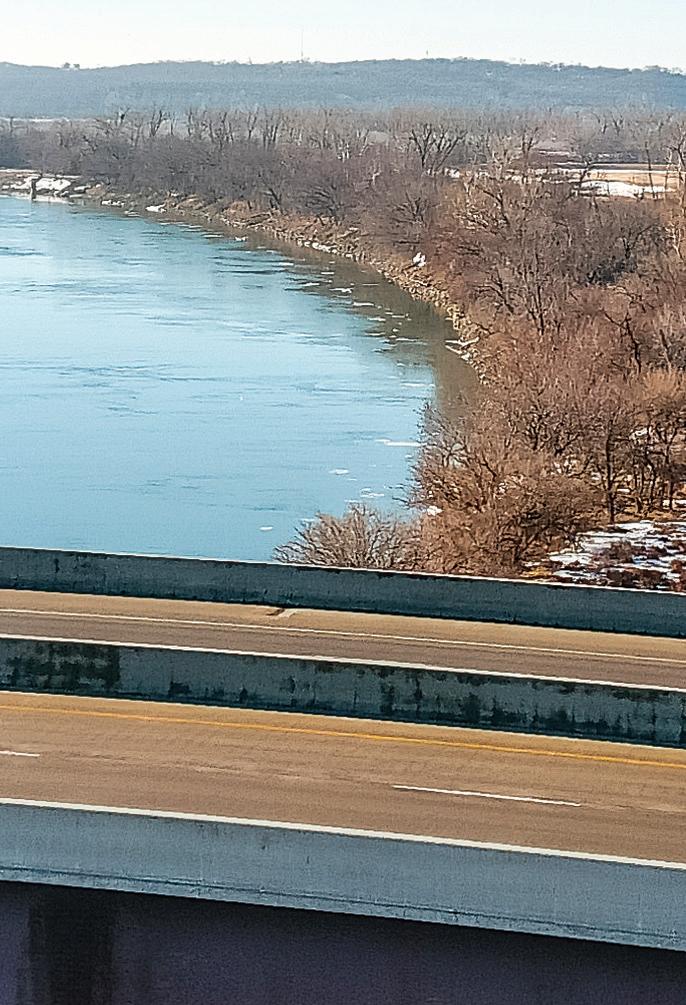




7 FEBRUARY 2024

Veterans
Continued from page 6
The restoration process took place at the Council Bluffs Airport. Students from Iowa Western Community College’s Aviation Maintenance program and volunteers from Offutt Air Force Base joined retired veterans with close associations to the Huey helicopter to restore the aircraft.
The helicopter will serve as a centerpiece of the statewide Memorial, which will honor the 396 Nebraska military personnel who were Killed In Action (KIA) during the Vietnam War and an additional four Sailors from the USS Evans.
Upon completion, the memorial will include an honor wall, the restored helicopter and rescue display, 11 obelisks creating a historical journey through the events of the Vietnam War, and flag poles for the flags of the United States, POW/MIA, and the five branches of the U.S. Military. Additionally there will be benches and greenspace for reflection and rest.
The Nebraska Vietnam Veterans Memorial Foundation is the organization behind this project. The mission and purpose of the foundation is to develop, erect and maintain a memorial to honor all veterans who served during the Vietnam War and further provide a lasting historical account for future generations. To learn more about the foundation visit, nvvmf.org.

Mark your calendars!
June 6, 2024 is the planned grand opening for this Nebraska monument honoring Vietnam Veterans from communities all over the state!
8 NEBRASKA MUNICIPAL REVIEW
The helicopter arrives at the site of the Nebraska Vietnam Veterans Memorial, currently under construction and located immediately south of SumTur Amphitheater in Papillion. Photos shared courtesy of City of Papillion.

The League Insurance Government Health Team (LIGHT) helps hundreds of
members throughout Nebraska obtain affordable health insurance coverage.
Plan and Network Choices
With seven plan options and three networks to choose from, you’re sure to find one that meets your group’s coverage and benefit needs.
Affordable Plan Options
Offering your employees much-needed protection against the high cost of medical care:
• Three PPO options
• Four HSA-eligible high deductible options
• Prescription drug coverage
Enrollment Options
Single: Covers the employee only
Employee and spouse: Covers the employee and their spouse
Employee and children: Covers the employee and their eligible dependent children, but does not provide coverage for the spouse
Family: Covers the employee and eligible dependents including a spouse
RECEIVE
WHEN YOU SWITCH!
Available Network Options
With several networks available,
have easy access to quality providers:
• NEtwork BLUE (Statewide)
• Premier Select BlueChoice (Regional)
• Blueprint Health (Regional)
• Out-of-state network availability
9 FEBRUARY 2024
you
Blue Cross and Blue Shield of Nebraska is an Independent Licensee of the Blue Cross and Blue Shield Association. 60-025-58 (01-17-23) LET’S GET STARTED Contact your current local Agent/Broker Or contact Dennis Maggart Executive Vice President P: 913-378-9841 or 816-718-0335 Dennis@McInnesGroup.com Jane Limbach Account Man ager P: 913-378-9840 Jane@McInnesGroup.com GET A QUOTE AND JOIN TODAY!
its
CREDIT
DEDUCTIBLE AND OUT-OF-POCKET
FROM YOUR CURRENT VALID GROUP PLAN
Under the open Sky Under the open Sky Under the open sky

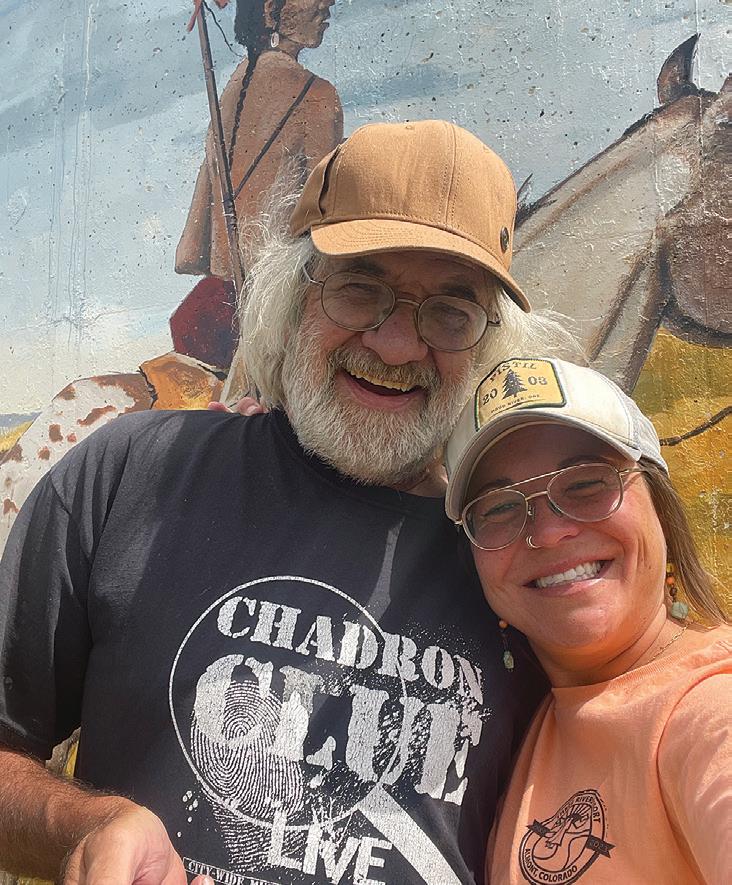
Chadron water tank repainted to reflect history of community
BY ASHLEY WOLFE, MARKETING DIRECTOR, LNM
The view of the hilltop water tank south of Chadron has a fresh new look thanks to a small group with a vision and passion for public art.
The tank, which was built in 1964, has tremendous importance for the community of 5,200. It draws water from the local wellfield and provides water for the residents of Chadron.
“The tank provides surge capability from the wellfield and relieves the pump from running for extended periods of time. The tank has a 250,000-gallon capacity and is 12-feet deep,” said Torey Zuver, Utilities Superintendent for the City of Chadron. It was previously painted by Kit Watson and Jeanne Moore around 2015, but after many years of facing the harsh Nebraska elements, the image was no longer visible and was in desperate need of a freshen-up. Tom Menke, Chadron’s City Manager is the one who can be credited with the vision to jumpstart the process. The city had just completed an internal refurbish and the time seemed right.
The artist who put the pencil to paper

10 NEBRASKA MUNICIPAL REVIEW
Above: An action shot of Jerry “Gov” Kathol painting the Chadron water tank. Right: Gov poses with Gabby Michna in front of the tank. Kathol, Michna and Chadron High School art teacher Travis Hencey were key people in the project. Below: The series of sketches Gov presented to the Chadron City Council. Photos provided by Gabby Michna

and turned the vision into a reality is Jerry “Gov” Kathol–a longtime local and staple artist in the Chadron community.
“You will find his artwork throughout town and other areas. Specifically showcased at The Bean Broker, Gov is an avid artist that does not go a day without creating, sketching, getting some sort of artwork to tickle his fancy and purpose,” said Gabby Michna, Executive Director at the Chadron Chamber of Commerce and another key person involved in the project.
In May 2023, the Chadron City Council met and

approved an updated design for the exterior of the tank. When presenting his idea to the City Council, Gov brought in a series of sketches to bring his vision to life for everyone else.
“I worked on some sketches,” Kathol said before presenting his design to the council. The project was a very large undertaking with the non-traditional canvas measuring 12 foot tall by 64 foot wide. In talking with community members about what they wanted to see, Kathol said the majority of people wanted to see something that reflected the fur trade—so that is just what he did.
Continued on page 21 / See Chadron

11 FEBRUARY 2024
Above: A work-in-progress photo of the Chadron water tank. The chosen imagery reflects the fur trade--something that holds special historical significance to the area. Right: A photo of the tank around the time it was prevously painted. Photo provided by Rob Pierce, LNM.

Growing
T

MMayor Joey Spellerberg delivers State of City address in Fremont
BY ASHLEY WOLFE, MARKETING DIRECTOR, LNM
ayor Spellerberg recapped the successes and outlined the plans for the future during his annual State of the City address in Fremont on Jan. 23.
Spellerberg made it clear that his mission since being sworn in as Mayor has remained the same—growing Fremont together. This theme of partnership and collaboration was woven throughout the length of his speech.
Notable achievements in 2023 include lowering the City’s property tax levy, the launch of a transit program, updating and expanding the city library, opening the Fremont Southeast Beltway and continued efforts to revitalize historic downtown while addressing housing and supporting business expansions within in the city.
In addition, Spellerberg gave a tremendous shoutout to street crews, first responders, and city staff for the ability to pivot and overcome challenges

12 NEBRASKA MUNICIPAL REVIEW
Above: Mayor Spellerberg’s State of the City address drew a crowd in late January. Right: City of Fremont employees who attended the dinner pose for a quick picture. From left to right: Finance Director, Jenn Nabb; Director of Planning, Jennifer Dam; Library Director, Laura England-Biggs; Streets Superintendent, Cari Hoffart; Grant Coordinator, Angie Olson; City Administrator, Jody Sanders; Director of Parks and Recreation, Nick Hansen; Fremont Transit Program Coordinator, Dakota Buesing; and Utilities General Manager, Jeff Shanahan.
Photos provided by City of Fremont/Fremont Chamber of Commerce
Mayor Joey Spellerberg
ogether
Continued on page 13 / See Fremont

Breaking new ground in Creighton
By the end of 2024, the city fire department will have a new home
A
collaboration between the City of Creighton and Creighton Rural Fire Department will result in the joint construction of a new fire department. The new facility is budgeted to cost $2.7 million. It will be positioned at the southeast corner of Nebraska Highway 59 and 13, will offer 14,400 square feet of space, and include 10 bays. This building also will serve as a housing facility for Creighton ambulances and will replace two smaller facilities that were no longer adequately serving the community first responders’ needs. The project has started and completion is expected by the end of the year.
Fremont
Continued from page 12
following the record snow fall, high winds and bitter cold in January.
“Maintaining safe and efficient roadways is a critical part of local government and the people in these roles over can be overlooked,” Spellerberg said. He went on to thank all involved for their long hours and tireless efforts to keep Fremont moving in spite of the weather.
During his speech, the Mayor also touched on the importance of state and federal grants to assist in the funding of municipal improvement projects. Out of the $47 million budgeted in 2023 for street, infrastructure and city improvements—just under $4 million of that came from grants. He stressed the importance of grants in taking the pressure off of tax dollars from the community.
When talking about the growth the city has seen over the
past few years, Spellerberg credited part of it with the great strides being made in Historic Downtown Fremont.
“Over the past several years, we have made some exciting efforts toward making our downtown a vibrant, familyfriendly, center of activity in the community,” he said. New businesses line the street—including restaurants, boutiques, a brewery, tea shop, grocery store, and more.
Finally, the Mayor touched on the $62 million Fremont Southeast Beltway and the impact that has made and how it positions Fremont for continued growth.
“Fremont is in one of the highest periods of growth in our history,” Spellerberg said. Later he also said, “With our job opportunities, updated schools, diverse housing options, cost-effective utilities, Fremont has strong momentum to maintain and grow our population in the future.”
13 FEBRUARY 2024
Photo provided by the City of Creighton
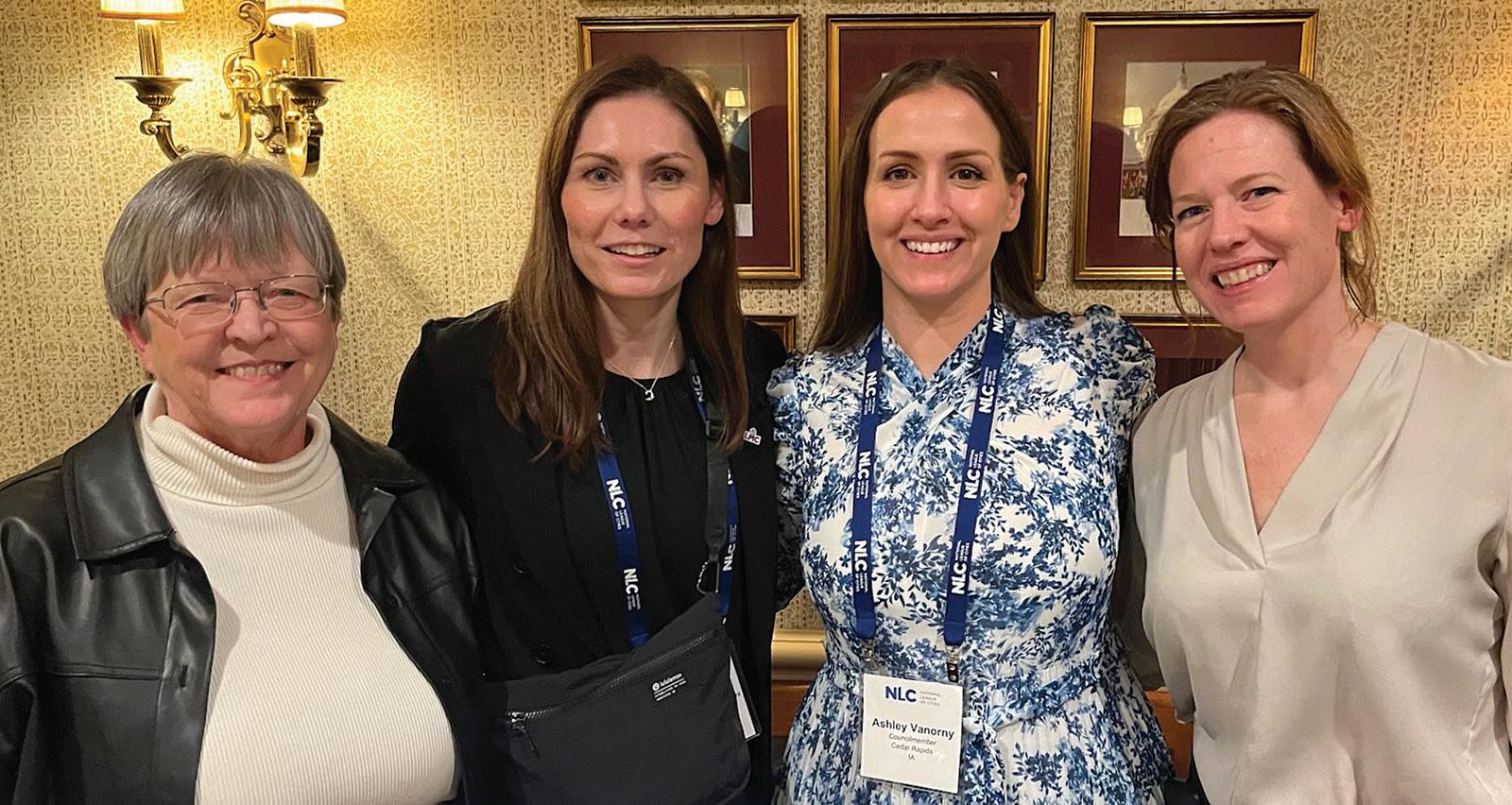


Build connections at NLC's Congressional City Conference in March
Join leaders from across the United States at NLC’s signature advocacy conference–the Congressional City Conference (CCC). The conference will be held March 11-13 in Washington, DC.
President Deb VanMatre participates in State Municipal League Executive Directors and Presidents Fly-In

At CCC, NLC brings together thousands of local government advocates from elected officials to municipal staff to highlight local priorities and emphasize the value of a strong local-federal partnership.
From cabinet secretaries to key program administrators, CCC attendees will connect to federal agencies and learn about billions in federal dollars available to local governments. Make this year the one you connect, engage and advocate as part of this coalition of 2,000+ local leaders.
For more information about the conference and to register visit ccc.nlc.org.
Source – National League of Cities
14 NEBRASKA MUNICIPAL REVIEW
of Cities
National League
Photo 1: Deb VanMatre, Mayor of Gibbon and League of Nebraska Municipalities President, poses for a picture with Andrea Fox, Program Director, State League Services with NLC, at the State Municipal League Executive Directors and Presidents Fly-In in Washington D.C. Photo 2: “Women Leaders of the Midwest” From left to right, President Deb VanMatre; Jenny Max, City Administrator, Nisswa, MN, League of Minnesota Cities; Ashley Vanorny, Councilmember, Cedar Rapids, IA, Iowa League of Cities; Emily Berge, Councilmember, Eau Claire, WI, League of Wisconsin Municipalities. Photo 3: President VanMatre’s view from her seat at the White House briefing.
2.
1.
3.

Build Connections.
NLC’s Congressional City Conference is where you can build connections with peers and meet federal o cials to support and strengthen your community.
15 FEBRUARY 2024
REGISTER TODAY at ccc.nlc.org/sml
USDA Rural Development:
Smell the roses!
Although winter is currently visiting us in Nebraska, Spring will be just around the corner. When the sun shines and the snow melts, rural community homeowners may discover some new maintenance issues amplified by father winter. USDA Rural Development has programs to step in and assist homeowners in any season. Also known as the Section 504 Home Repair Program, it provides low interest loans to homeowners to repair, improve, or modernize their homes. It also provides elderly (over 62 years of age), with options for grant or, loan and grant combinations, to remove or repair health and safety hazards. Additionally, funding is available under the Rural Disaster Home Repair Grants to homeowners in 23 designated Nebraska counties who have properties that sustained damage or effects from the storm in the 2022 Presidential disaster declaration.
Let’s take a trip to Scottsbluff for just one example of how these funds can assist.
Harriet, an 87-year-old single female and homeowner in the Scottsbluff community, was living on a limited, fixed, social security income. Her home, an 808 square foot home built in 1935, had been in the family for many years. Harriett had been having trouble with her sewer line for quite some time. The problem was discovered to be between her house and the city main, so it was determined that it was her responsibility to have the repairs completed. Since she did not have the funds for the repairs, she did the best she could. For months, she was very careful not to put any paper products in her toilet and frequently took showers in the homes of friends and neighbors.
A friend heard about USDA Rural Development’s 504 program and assisted Harriet to apply. USDA Rural Development was able to provide grant funds in the amount of $5,500 to install a new sewer line from the house to the city connection in the alley. The contractor dug an entry opening near her house and an exit to the alley, then pulled the line through her old existing clay pipe bursting it and replacing it with a seamless new pipe all at the same time. This was all accomplished without digging up the entire yard and destroying her rose bushes!
Harriet was very grateful that she heard about USDA Rural Development programs for homeowners, and that they were able to provide the assistance she needed, all without disturbing her beloved rose bushes.
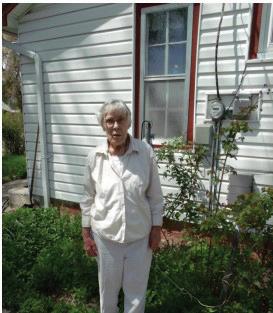
Section 504 Home Repair Program
Home Repair Loans and Grants:
Funds may be used to repair, improve, or modernize homes or remove health and safety hazards. Grants must be used to remove health and safety hazards. Maximum loan amount of $40,000. Maximum grant amount is $10,000. Loans are termed for 20 years, and interest rate is fixed at 1%. Homes must be owned and occupied in a rural community and income guidelines do apply.
Single Family Housing Rural Disaster Home Repair Grants:
Funds may be used for disaster related home repair expenses (including costs incurred prior to application). Maximum grant is $40,675. Grant recipients must certify that there is no duplication of benefits with the award and income guidelines do apply.
To learn more about any and all of the USDA Rural Development Programs that might be of value to your community, visit its website at rd.usda.gov/ne or call its main line at (402) 437-5551.

16 NEBRASKA MUNICIPAL REVIEW
Harriet, homeowner in Scottsbluff, loves her roses.
Together, America Prospers
Single Family Housing Repair Loans and Grants
What does this program do?
Also known as the Section 504 Home Repair program, it provides loans to very-low-income homeowners to repair, improve, or modernize their homes, or provides grants to elderly, very-low-income homeowners to remove health and safety hazards.
Who can apply?
To qualify, you must:
• Be the homeowner and occupy the house
• Be unable to obtain affordable credit elsewhere
• Have a family income within the very-low-income limit
• For grants, be age 62 or older

Home Repair Program Webpage
What is an eligible area?
Properties must be located in an eligible rural area. You can visit the USDA Income and Property Eligibility website (available at this link: https:// go.usa.gov/xzcdM) for complete details.
How can funds be used?
• Loans can be used to repair, improve, or modernize homes, or to remove health and safety hazards.
• Grants must be used to remove health and safety hazards.
How much money can I get?
• Maximum loan is $40,000.
• Maximum grant is $10,000.
• Loans and grants can be combined for up to $50,000 in assistance.
What are the terms of the loan or grant?
• Loans are repaid over 20 years.
• Loan interest rate is fixed at 1 percent.
• Full title service is required for loans greater than $25,000.
• Grants have a lifetime limit of $10,000.
• Grants must be repaid if the property is sold in less than three years.
Is there a deadline to apply?
Applications are available year-round as long as funding is available, and are processed in the order they are received.
How long does an application take?
Approval times depend on funding availability in your area. Talk to a state or area office-based USDA home loan specialist (a map is available at this link: https://www.rd.usda.gov/browsestate) for help with your application.
How do I get started?
Contact a USDA home loan specialist (information is available at this link: https://www.rd.usda.gov/browse-state) in your area.
What governs this program?
• The Housing Act of 1949 as amended; 7 CFR, Part 3550 (available at this link: https://go.usa.gov/xzcvG)
• HB-1-3550 - Direct Single Family Housing Program Field Office Handbook (available at this link: https://go.usa.gov/xzcvM - PDF)
NOTE: Because information changes, always consult official program instructions or contact your local Rural Development office for help. A list is available at this link: https://go.usa.gov/xJHPE. You will find additional resources, forms, and program information at https://rd.usda.gov.
USDA is an equal opportunity provider, employer, and lender.
Last Updated May 2023
17 FEBRUARY 2024
A YEAR TO REMEMBER IN COZAD
BY NIKKI SCHWANZ COZAD CITY ADMINISTRATOR
2023 has been a year of celebration in the City of Cozad as it marked its 150th anniversary!
For the City of Cozad, choosing a theme, or rather the series of themes was fairly simple–just dig back in history. The 2023 celebration events centered around four key ideas, each with significant meaning for the community: the Union Pacific Railroad, the arts, agriculture and the 10th Meridian. First off, the Union Pacific Railroad, because that initially brought John J. Cozad to the area. Next, the arts have a special importance to the area because of Robert Henry Cozad, now known as American artist Robert Henri, and a multitude of other community members with a strong commitment to the arts. For Cozad, agriculture also has a strong importance as the community is known as the Alfalfa Capital of the World, and the 100th Meridian signifies Cozad’s location on the map and serves as a symbol of where the arid West begins.

Cozad’s celebration was kicked off on New Year’s Eve with a Roaring into Cozad’s 150th Year 1920s costume contest and dance. Wilson Public Library held a Tiny Art Show with the theme, 150 Years of Cozad, as well as hosted numerous historical talks throughout the year in conjunction with the Robert Henri Museum. The Celebration Committee held a Business After Hours on May 5 with free street tacos to thank sponsors. A co-ed softball tournament was held in June after a successful fundraising one held the year before. In July, the city celebrated an Old-Fashioned Independence Celebration that was full of various tournaments and contests, including a Vintage Baseball game between the Cozad Legends and the STAR BBC of Colorado Territory and
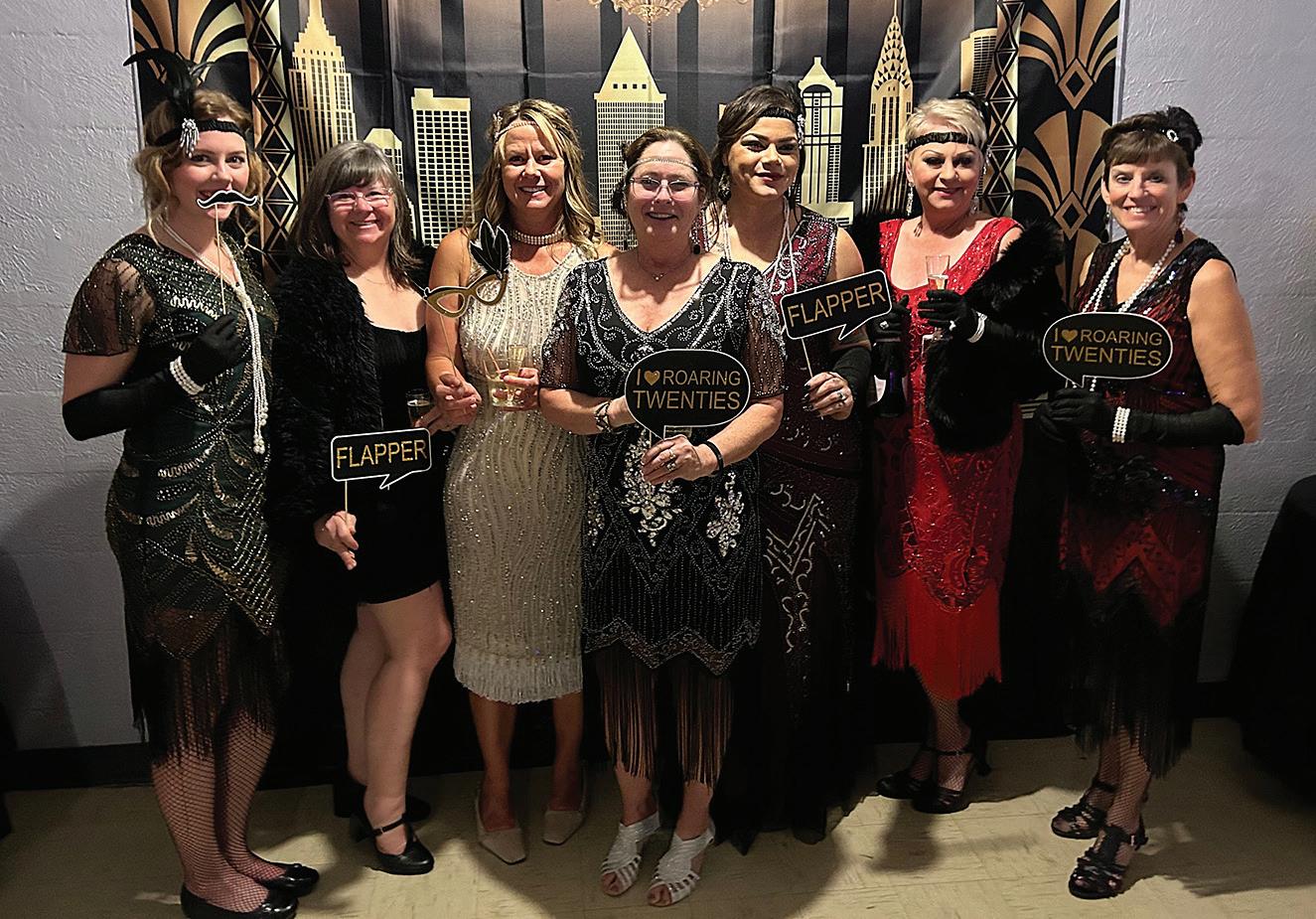
ending with a spectacular fireworks show. A poker run, also back by popular demand, was held in August, as the retailers celebrated Quilts Around the Block: 150 Years of Quilting.
The summer ended with our annual Hay Days celebration using the city’s birthday theme and there was the retrieval of a time capsule buried in
18 NEBRASKA MUNICIPAL REVIEW
Cozad’s Celebration was kicked off on New Year’s Eve with a Roaring into Cozad’s 150th Year 1920s costume contest and dance. Photos provided by Nikki Schwanz/City of Cozad



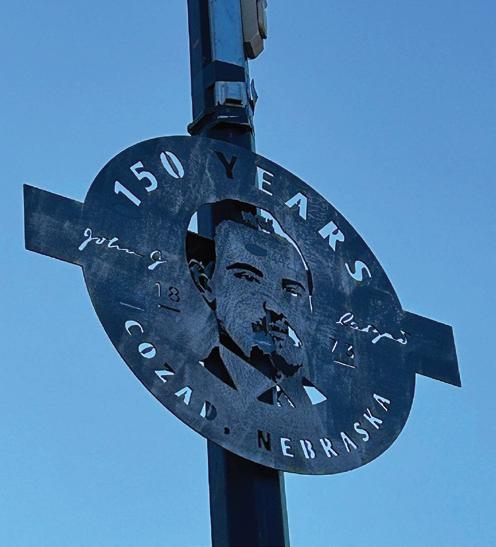
1973 under a brick walkway downtown. A plaque placed over it read, “Cozad Centennial. 1873-1973. Beneath this plaque lies Cozad Rotary Club Mementos of 100 years. Do not disturb until the year 2023.” Waypoint Bank displayed the memorabilia in its windows until late September and the Cozad Rotary is finalizing plans to bury another time capsule with original and additional memorabilia and instructions to leave until 2073. Wrapping up Cozad’s 150th Celebration was an Old-Fashioned Christmas weekend full of Santa visits, reindeer petting thanks to Blue Star Christmas Tree & Reindeer Farm, and a tree lighting ceremony. A proclamation ceremony was held at the Cozad Train Depot with Mayor Kloepping presenting a city proclamation followed by our special guest Senator Ibach reading a state proclamation. Finally, the Celebration Committee held a Christmas light contest to get the community even more involved. The celebration truly was a community affair. Besides numerous businesses financially sponsoring the events, many others stepped up to donate items needed or volunteer people for different events. The Cozad Tourism Committee had a new barn quilt made for the museum. The Business Improvement District collaborated with the Celebration Committee to fund banners representing all four themes which alternated quarterly throughout the downtown corridor. Additionally, four steel signs of the logo were placed on the main stoplights downtown. Two of the signs will be auctioned off in 2024 with proceeds

benefitting Cozad Community Leaders (formerly Jaycees) and the Cozad Community Foundation, while the other two will take a place of honor at the 100th Meridian Museum and the City of Cozad, respectively.
19 FEBRUARY 2024
Photo 1: In July, Cozad celebrated an Old-Fashioned Independence Celebration that included various tournaments and contests, including a Vintage Baseball game between the Cozad Legends and the STAR BBC of Colorado Territory.
Photo 2: A proclamation ceremony was held at the Cozad Train Depot with Cozad Mayor Marcus Kloepping presenting a city proclamation followed by Sen. Ibach reading a state proclamation. Photos 3 & 4: Four steel signs of the logo were placed on the main stoplights downtown. Two of the signs will be auctioned off, while the other two will take a place of honor at the 100th Meridian Museum and the City of Cozad, respectively.
1.
2.
3.
4.
Recycling Council seeks input from municipalities on waste reduction
The Nebraska Recycling Council (NRC) is developing Municipal Waste Reduction Toolkits in 2024 and looking for participation from industry professionals. They value input from subject matter experts around the state who divert material from the landfill. NRC is able to provide this resource to Nebraska communities through funding from the Nebraska Department of Environment and Energy.
If you’d like to join the group please reach out to the NRC Director Haley at director@nrcne.org.
Source – Nebraska Recycling Council
Snow Fighter Recognition Week Proclaimed
According to Gov. Pillen, Feb. 12-16, serves as a reminder of the critical importance of winter snow operations before, during, and after storms
“Snow Fighters Recognition Week provides an opportunity to thank those public servants who spend countless hours in the cabs of snow plows and snow blowers during the winter months. When the need arises, they clear our roadways, ensuring that Nebraskans get to their destinations as safely as possible.”
- Gov. Jim Pillen


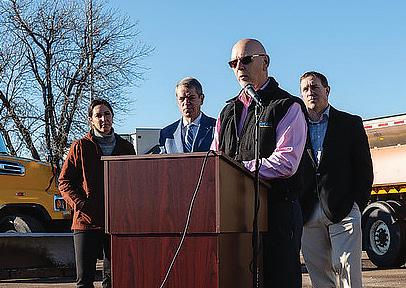
Over 49 million homeowners will put themselves at risk this year by not contacting 811 before digging.*
Whether you’re an excavator or a facility operator, keep yourself and those around you safe by helping to increase awareness about the importance of contacing 811 before digging.
*According to a February 2023 survey of American homeowners.





















20 NEBRASKA MUNICIPAL REVIEW
Find us online
Source – NDOT
Chadron

Continued from page 11
The chosen imagery is ripe with symbolism and meaning to the community of Chadron. The entire mural is done in autumn colors and on one end there are fur traders and Native Americans on the opposite side with a trading post in the middle. The project took a total of one month to complete.
“Gov is exceptionally talented and extremely generous. He has donated his time and talents to us working with Art Alley and Paint the Town efforts, and the City of Chadron graciously funded this beautifully historic rendition that captures something our community is best known for, The Fur Trade,” Michna said.
Before Chadron was even a community it was the site of a fur trading post built in 1841, managed by Louis B. Chartran, the person who later became the namesake for the City. The fur trade is often thought of as North America’s first commercial industry and this history is celebrated each year at Fur Trade Days.
“The location of the 250,000-gallon tank provides a perfect canvas for the mural that was designed and created by Mr. Kathol as a gateway to the Pine Ridge and the City of Chadron,” said Janet Johnson, Zoning and Building Official with the City of Chadron.

Visionary: Tom Menke, Chadron City Manager
Artist: Jerry Kathol (The Gov)
Timeline: Executed in June 2023
Supporting entities: Chadron Art Alley & Paint the Town, City of Chadron and the Water Tower Mural Committee— consisting of: Don Huls, John (Doc) Gamby, Tom Menke, Tory Groover, George Klein, Travis Hencey, Gabby Michna

21 FEBRUARY 2024
Engineering a world where everyone thrives. Engineering | Architecture | Surveying | Planning jeo.com Contributing partners on the project:
Jerry Kathol, more commonly known in Chadron as Gov, uses the darkness of night in his favor when projecting his art onto the tank to later be painted. Photo provided by Gabby Michna

FEMA listens to feedback, reforms disaster assistance program
Quicker access to funds, expanded eligibility, and an easier application are among the changes
With an increased frequency of extreme weather events fueled by climate change, FEMA recently announced reforms of federal assistance policies and expanding benefits for disaster survivors to cut the red tape and provide funds faster.
These changes were developed by FEMA developed based on direct feedback from survivors and in response to the threats the nation faces due to our changing climate. The hope is they will create more equitable outcomes for all communities by increasing accessibility and eligibility for post-disaster support.
To benefit those experiencing disasters, FEMA is establishing new benefits that provide flexible funding directly to survivors when they need it most.
• Establishing Serious Needs Assistance: FEMA is standardizing immediate financial support by replacing the Critical Needs Assistance program with Serious Needs Assistance. The new program is a cash relief program and will be available in all disasters receiving Individual Assistance. The payment of $750 for households with serious needs will help cover immediate expenses. This payment would be in addition to other eligible assistance that may be provided.
• Establishing Displacement Assistance: This program is designed for those who cannot return to their home following a disaster and provides up-front funds to survivors to allow greater flexibility in making the best decision for their immediate housing needs.
FEMA also is cutting red tape and expanding eligibility to reach more people and help them recover faster.
• Removing loan application requirements: FEMA listened to feedback and is removing the requirement that survivors apply for a Small Business Administration (SBA) loan before being considered for certain types of financial assistance.
• Helping under-insured survivors: FEMA is streamlining insurance-related rules to help survivors who do not receive enough assistance from their insurance company to cover rebuilding costs.
• Simplifying assistance for entrepreneurs: FEMA is simplifying the process so entrepreneurs, gig workers and other self-employed individuals can more easily reopen their businesses after a disaster.
• Expanding habitability criteria: FEMA is simplifying its definition of “habitability” to broaden eligibility to include repairs to homes with pre-existing conditions.
• Making accessibility improvements: Survivors with disabilities can use FEMA funding to make certain accessibility improvements to homes damaged by a declared disaster. This change helps survivors with disabilities improve their living conditions by making their homes even more accessible than they were pre-disaster.
Finally, FEMA is seeking to simplify the application process to meet survivors’ where they are. This includes, removing barriers for late applicants, streamlining temporary housing assistance applications, and simplifying the appeals process.
FEMA expects the changes to take effect for new disasters declared on or after March 22, 2024. In addition to the planned updates outline above, improvements also have been made to make DisasterAssistance.gov and the Transitional Sheltering Assistance websites more accessible and easier to navigate for survivors.
Note: This is a condensed version of a release sent out by Hannah Dickel, Congressional and Intergovernmental Affairs Liaison for FEMA Region 7.
22 NEBRASKA MUNICIPAL REVIEW



23 FEBRUARY 2024
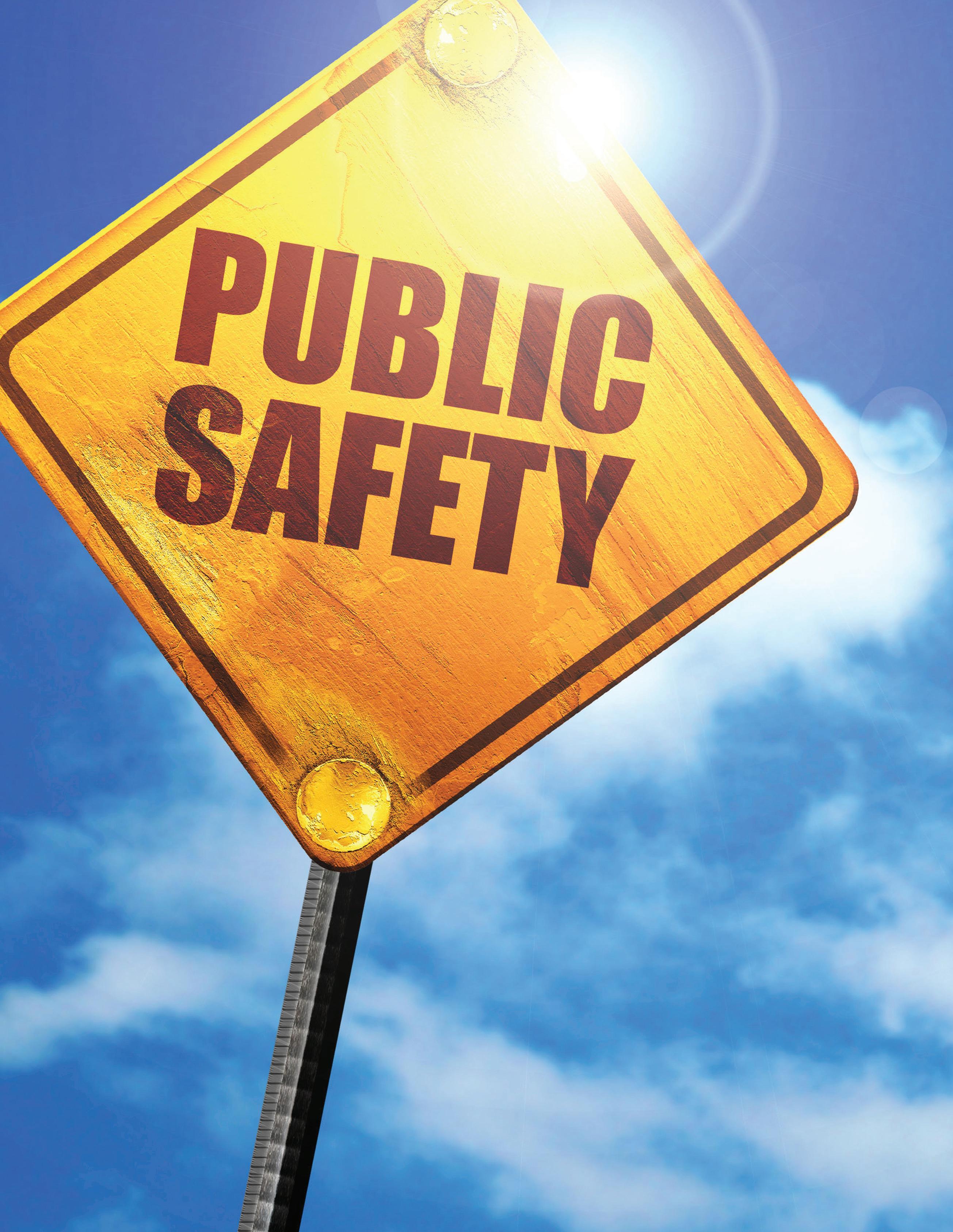
If you see something, say something. “ ”
If you saw a co-worker doing something blatantly unsafe, would you say something or not? It’s a question that’s getting a lot of attention in the law enforcement world and the issue is an important one to consider when working in most other vocations, also.
Scot Huntsberry, Investigations Specialist with Sheppard Mullin based in the Washington D.C. area, recently spoke at the National League of Cities – Risk Information Sharing Consortium (NLC-RISC) staff conference. He said that many, if not most, accidents or injuries occur because someone did not speak up when they noticed something was amiss or unsafe.
He noted one case when a supervising officer didn’t handcuff a suspect correctly. Many of his subordinates had seen there was an issue but no one had said anything. As a result, the suspect was able to get out of the cuffs, grab a nearby revolver, and kill an officer. Saying something about the incorrect handcuff procedure almost assuredly would have saved a life.
There are many instances when a person could speak about something - like telling a co-worker they shouldn’t string the coffee pot cord across their desk or shouldn’t leave an important shed door unlocked but they don’t. Why not?
Huntsberry said there are many reasons a person hesitates to intervene when they see something that isn’t right. He said it might be fear of retaliation, discipline, ostracization, being wrong, public scrutiny, not being supported, or they might be afraid of making things worse. Another reason a person might not say anything would be a lack of knowledge or skill (is it right or not?), lack of confidence, lack of courage, lack of emotional energy, lack of internal impetus to help, or a lack of empathy for the other person(s).
Other factors as to why a person won’t speak up may be a “defusion of responsibility” which means they may not understand whose responsibility it is to correct mistakes or they’d rather wait and have someone else say something about the problem. It may be “pluralistic ignorance” which is the idea that no one else says it’s wrong so I guess it’s okay. They may have bias against the perpetrator or other person or the person may want the wrongdoer to face the consequences of what they have done. It might just be a matter of being comfortable with the status quo (the cord has always laid across my co-worker’s desk and nothing’s happened yet).
Huntsberry said that the Active Bystanders for Law Enforcement (ABLE) program is working to encourage more people to speak up if
 BY DAVE BOS, EXECUTIVE DIRECTOR, LARM
BY DAVE BOS, EXECUTIVE DIRECTOR, LARM
they see something that may not be right. “We give people the permission to intervene and teach them how to intervene. We also show the managers how to create a culture that expects intervention,” Huntsberry said. When someone sees a problem and speaks up about it, the issue might be taken care of and prevent an incident or an internal investigation later on.
Huntsberry said the ABLE program teaches participants the four steps in the acronym “PACT” – Probe, Alert, Challenge, Take Action.
Huntsberry said the campaign, “Friends don’t let friends drive drunk” was one of the first safety intervening messages. It might be part of the reason that drunk driving incidents have decreased 30% since the campaign came out.
Huntsberry ended with a quote – “Active bystandership creates stories that will never be told because nothing happened.”
24 NEBRASKA MUNICIPAL REVIEW

25 FEBRUARY 2024
Fischer, Ricketts announce $15.3 million investment in airport infrastructure statewide
On Jan. 30, U.S. Senators Deb Fischer and Pete Ricketts announced the Nebraska Department of Transportation (NDOT) will receive $15.3 million in federal funding.
“From Omaha to Chadron, Atkinson to Lexington — Nebraska’s airports connect our communities, ensure accessibility for travel, and grow the rural economy,” said Sen. Fischer. “I was proud to vote for the Bipartisan Infrastructure Law to support Nebraska’s airports. Nebraska continues to see a return on that investment, as our state will now receive $15.3 million to support and maintain essential airports statewide.”
These funds will be used to enhance and maintain existing infrastructure at 21 airports statewide. The top three recipients are Eppley Airfield, North Platte-Lee Bird Regional Airport, and the Lincoln Airport.
“Nebraska’s airports are essential to our state’s economy,” said Sen. Ricketts. “These strategic investments in critical infrastructure will improve safety and support the continued growth of communities across our state.”


•
•
•
•
•
•
•
•
•
•
•
•
•
•
•
•
•
•
•
•
•


•
•
•
TOTAL INVESTMENT: $15, 301, 750

26 NEBRASKA MUNICIPAL REVIEW D.A. Davidson & Co. is committed to strengthening the infrastructure and enriching the lives of people in our communities throughout Nebraska and across the nation. Our bankers specialize in: • Bond Anticipation Notes • Paving Bonds • Water and Sewer Bonds • General Obligation Bonds • Utility System Revenue Bonds • Lease-Purchase Financing Call: (800) 528-5145 I Paul Grieger (866) 809-5596 I Cody Wickham (866) 809-5443 I Andy Forney (866) 466-9368 I Jerry Spethman 450 Regency Parkway, Suite 400 Omaha, NE 68114 | (800) 206-7523 D.A. Davidson & Co. member FINRA and SIPC dadavidson.com Building a better future in NEBRASKA with a strong Public Finance Partner NEBRASKA DEPARTMENT OF TRANSPORTATION GRANT AWARD NOTICE AIRPORT GRANT AMOUNT CITY • Eppley Airfield • North Platte Regional/ Lee Bird Field • Lincoln Airport • Blair Executive • Jim Kelly Field • Columbus Municipal • Plattsmouth Municipal • Seward Municipal • Chadron Municipal • Central Nebraska Regional • Nebraska City Municipal • Central City Municipal/ Larry Reineke Field • Broken Bow Municipal/Keith Glaze Field • Stuart-Atkinson Municipal
Millard • Brenner Field
Hastings Municipal
Scribner State
•
•
•
Sidney Municipal
Cram Field
Modisett
Omaha
North Platte
Lincoln
•
Blair
Lexington
Columbus
Plattsmouth
Seward • Chadron • Grand Island • Nebraska City • Central City
Broken Bow • Atkinson • Omaha
Falls City
Hastings
•
•
•
•
•
•
Scribner
Sidney
Burwell
Rushville • $5,371,090 • $2,689,920
$1,458,000 • $504,000
$448,000
•
•
•
•
•
$448,000
$448,000
$448,000
$351,500
$346,750
$336,000
$333,000
$324,000
$306,000
$293,400
$277,200
$446,850
$167,040
$144,000
$113,000
$48,000
Exploring AI applications in city government: The promise and the risks
BY JOSHUA PINE AND LENA GERAGHTY, IN COLLABORATION WITH KATE STOLL AND DANIELLE GREY-STEWART
Artificial intelligence (AI) is changing the landscape of work and local governments are by no means exempt. Cities, towns, and villages can harness the power of AI to draft resolutions, create social media content, summarize information for constituents, improve data-driven decisionmaking, and more. However, not all municipal applications are suitable for AI, and not all AI technologies are appropriate for government use.
To discuss the opportunities and risks of AI for local leaders, the National League of Cities and the American Association for the Advancement of Science Center for Scientific Evidence in Public Issues co-hosted a virtual event in August 2023 titled, “Introduction to AI in Municipal Government.”
Although the conversation was just the tip of the iceberg when it comes to AI applications and policies by municipal governments, several key takeaways come from the event:

Artificial intelligence is not a magical solution. We heard from Professor Hoda Heidari, co-leader of the Responsible AI Initiative at Carnegie Mellon University, about how AI utilizes statistical processes designed to find patterns in data. This can be a valuable tool for local leaders. However, like human-made decisions, AI systems have the potential for bias and discrimination depending on their training, the data they use, and their ultimate application. Extra care should be exercised when AI is used to inform consequential decisions or to provide risk assessments that impact people’s lives.

There are many types of AI. Generative AI, like ChatGPT or Google Bard, is just one type of technology. Generative AI for text works by predicting the next word in a sentence, and the next sentence in a paragraph and so on, based upon what’s most likely to follow according to text pulled from many sources, including the Internet. Generative AI does not generally test for accuracy—humans should fact check its outputs.

Experiment but verify! The City of Boston, MA’s Interim Guidelines for Using Generative AI highlight how AI tools have significant potential to

benefit the work of city employees. This potential does not, however, remove responsibility of staff for its output, which is why verification and accountability are essential. Boston’s Chief Information Officer, Santiago Garces, emphasized three guiding principles:
1. Fact check and review all Generative AI outputs: Humans are ultimately responsible for whatever products or outcomes they publish, regardless of whether AI is used.
2. Disclose when Generative AI has been used: Constituents expect transparency from their local government.
3. Do not share sensitive or private information: The information input into Generative AI prompts is not inherently private and therefore could be vulnerable to security threats or could be taken by the company providing the model to further train their technology.

AI is not just for big cities. Whereas other emerging technologies often require significant technical training and staff resources, Generative AI tools based on natural language inputs allow cities of all sizes to benefit from its value. The City of Wentzville, MO, is piloting Generative AI tools to automate certain aspects of city communication, which creates more time and space for creative and strategic thinking by city staff. Wentzville offers in-person training and requires virtual training for staff on the use of Generative AI.
The August event merely scratched the surface of the many questions raised about the promise and peril of AI applications in local government. What questions do you have about using AI in your city or village? What creative applications of AI can propel your municipality into the digital future? What guardrails should be put in place to ensure the safe use of AI in your community?
To learn more about AI, visit the AAAS EPI Center resources (https://www.aaas.org/programs/epi-center/AI ).
27 FEBRUARY 2024
This article was originally published by NLC. Joshua Pine is the program manager of urban innovation at NLC. Lena Geraghty is the director of urban innovation and sustainability in the Center for Municipal Practice at NLC. Kate Stoll and Danielle Grey-Stewart are with the AAAS Center for Scientific Evidence in Public Issues.
 Jeremiah J. Perkins
Jeremiah J. Perkins
AAbandoned and neglected property management methods: the Vacant Property Registration Act
BY JEREMIAH J. PERKINS, CLINE WILLIAMS WRIGHT JOHNSON & OLDFATHER, L.L.P.
bandoned and neglected property are some of the most significant sources of urban blight in Nebraska cities and villages. Abandoned and neglected property not only create an eyesore for the community, but also lead to an increase in crime, declining property values, and the withdrawal of valuable economic activity. Despite the significant pitfalls associated with abandoned and neglected property, municipalities may face challenges in cleaning up their communities. However, in March of 2018, the Nebraska Legislature provided Nebraska municipalities with a promising option: the Vacant Property Registration Act. The Vacant Property Registration Act, Neb. Rev. Stat. §§ 19-5401 to 19-5408 (the “Act”), provides Nebraska municipalities with a method for disincentivizing property vacancies as well as maintaining those already vacant. More specifically, the Act enables municipalities to create a database of vacant properties and their owners, maintain unoccupied properties, and assess fees for the public costs associated with the maintenance and outright existence of vacant properties.i
This article will discuss the determination of whether a property is considered vacant under the Act, the procedure for creating and implementing a vacant property registration, and the fees a municipality may charge the owners of vacant properties following creation of a vacant property registration.
A. Defining Vacant Property
The Act defines “vacant’ as any residential or commercial building that exhibits evidence of vacancy.ii Further, “vacancy” is defined as “any condition or circumstances that on its own or in combination with other conditions or circumstances would lead a reasonable person to
believe that a residential building or commercial building is vacant.”iii The Act goes on to provide a non-exhaustive list of conditions and circumstances of vacancies, including:
1. Overgrown or dead vegetation, including grass, shrubbery, and other plantings;
2. An accumulation of abandoned personal property, trash, or other waste;
3. Visible deterioration or lack of maintenance of any building or structure on the property;
4. Graffiti or other defacement of any building or structure on the property; or
5. Any other condition or circumstance reasonably indicating that the property is not occupied for residential purposes or being used for the operation of a lawful business.iv
B. Creating and Implementing the Vacant Property Registration
The Act permits a municipality to adopt a vacant property registration ordinance that is applied to any type of nonfederal vacant property (as defined by Section A above) located within its corporate limits.v The vacant property registration ordinance, among other things, must create a city- or village-wide vacant property registration database. It also must designate an individual to administer the program.vi
Following adoption of the vacant property registration ordinance, all owners of vacant property subject to the ordinance must register their property with the program administrator once the property has been vacant for at least 180 days.vii The registration form must contain the following information:
1. The name, street address, mailing address, telephone number, and, if applicable, the facsimile number and
28 NEBRASKA MUNICIPAL REVIEW
THE LEGAL CORNER
email address of the property owner and their agent;
2. The street address and parcel identification number of the vacant property;
3. The transfer date of the instrument conveying the property to the owner; and
4. The date on which the property became vacant.viii
The vacant property registration must provide certain exemptions to the registration and fee requirements for properties advertised in good faith for sale or lease. Additionally, it may provide exemptions to the registration and fee requirements for, among other things, vacant property that is a seasonal residence, damaged by an act of God or vandalism, under construction, or where the owner is temporarily absent.ix
C. Imposing Fees for Vacant Properties
The vacant property registration ordinance may require payment of up to $250 for residential properties and $1,000 for commercial properties after the earlier of (i) 180 days following the initial registration of the property by the owner, or (ii) 360 days after the property becomes vacant.x Thus, even if the property owner does not register the property, the municipality may still institute the fines provided above, provided the property is considered vacant for at least 360 days following adoption of the ordinance. In addition, the ordinance may require the payment of supplemental registration fees in an amount that is double the previous fee every six months after the first fee is instituted; however, the supplemental registration fee may not exceed an amount that is 10 times the initial registration fee amount (i.e., $2,500 for residential and $10,000 for commercial).xi
Should the vacant property registration fees imposed pursuant to the ordinance remain unpaid, the Act mandates that such fees become a lien on the vacant property upon recording of a notice with the local register of deeds.xii This lien enables municipalities to foreclose upon the vacant property, potentially changing ownership hands and further incentivizing beneficial ownership of the vacant property.
D. Conclusion
The adoption and implementation of a vacant property registration ordinance provides a valuable method for combatting urban blight in Nebraska cities and villages. The Act enables local municipalities to incentivize the beneficial use of the property by requiring owners to utilize their property to avoid the imposition of substantial fees. These fees also could be utilized to maintain the property before the property is acquired by the municipality or a redeveloper. If such fees are not paid, they become a foreclosable lien, providing yet another route to the transfer and rehabilitation of abandoned and neglected property.
Editor’s Note: This article is not intended to provide legal advice to its readers. Rather, this article is intended to alert readers to new and developing issues. Readers are urged to consult their own legal counsel or the author of this article if they wish to obtain a specific legal opinion regarding their particular circumstances. The author of this article, Jeremiah J. Perkins, can be contacted at Cline Williams Wright Johnson & Oldfather, L.L.P., 233 S. 13th St., Ste. 1900, Lincoln, NE 68508, (402) 474-6900, jperkins@clinewilliams.com, or www.clinewilliams.com 4875-1193-4873, v. 2
Endnotes
i Neb. Rev. Stat. § 19-5402(4).
ii Id. § 19-5404(1).
iii Id.
iv Id. § 19-5404(2).
v Id. § 19-5405.
vi Id.; Section 19-5407 contains various other requirements of a vacant property registration ordinance that are not discussed in this article.
vii Id. § 19-5406(1).
viii Id. § 19-5406(1).
ix Id. § 19-5406(2).
x Id
xi Id
xii Id. § 19-5407.



29 FEBRUARY 2024 800-383-PUMP www.electricpump.com 402-333-9660 www.mc2h2o.com You can count on us for all your fluid handling and process solutions! An Electric Pump Company









30 NEBRASKA MUNICIPAL REVIEW Financial & Single Audits Budget Consulting & Preparation Retirement Plans Benchmarking & Rate Studies Contact Marcy Luth, Michael Hoback Joe Stump, Kyle Overturf or Tracy Cannon 1203 W. 2nd Street Grand Island, NE 68801 Ph 308.381.1810 Fax 308.381.4824 www.gicpas.com Terry Galloway PO Box 108 | 309 Smith Ave Elwood, NE 68937 www.GallowayFinancialAdvisors.com ENGINEERING ARCHITECTURE CONSTRUCTION FIELD SERVICES Omaha - 402.493.4800 | Lincoln - 402.488.2500 SCHEMMER.COM MUNICIPAL CODE SERVICES, INC. MUNICIPAL CODE REVISION BASIC CODE FOR SMALL VILLAGES UPDATING FOR AMERICAN LEGAL AND OTHER CODES UPDATING FOR ZONING REGULATIONS POLICY MANUALS Personal Service / Nebraska Company P.O. Box 164, Neligh, NE 68756 Phone 402.887.5022 leagle@mcnallylaw.net www.mcodeservices.com PROFESSIONAL DIRECTORY
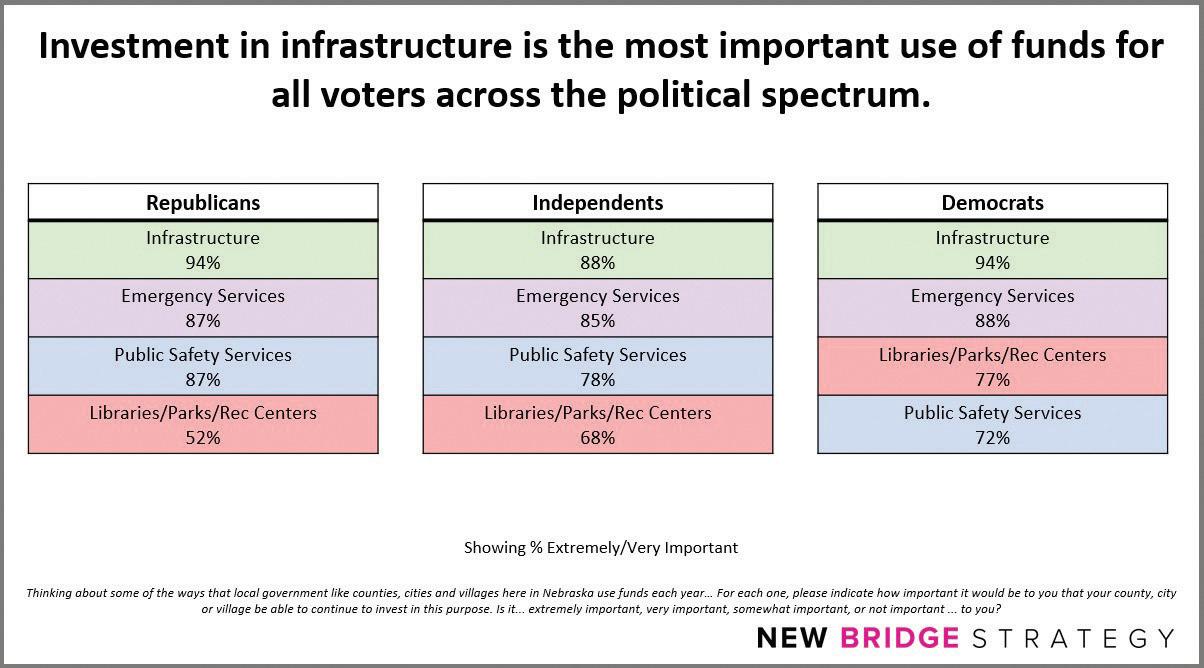
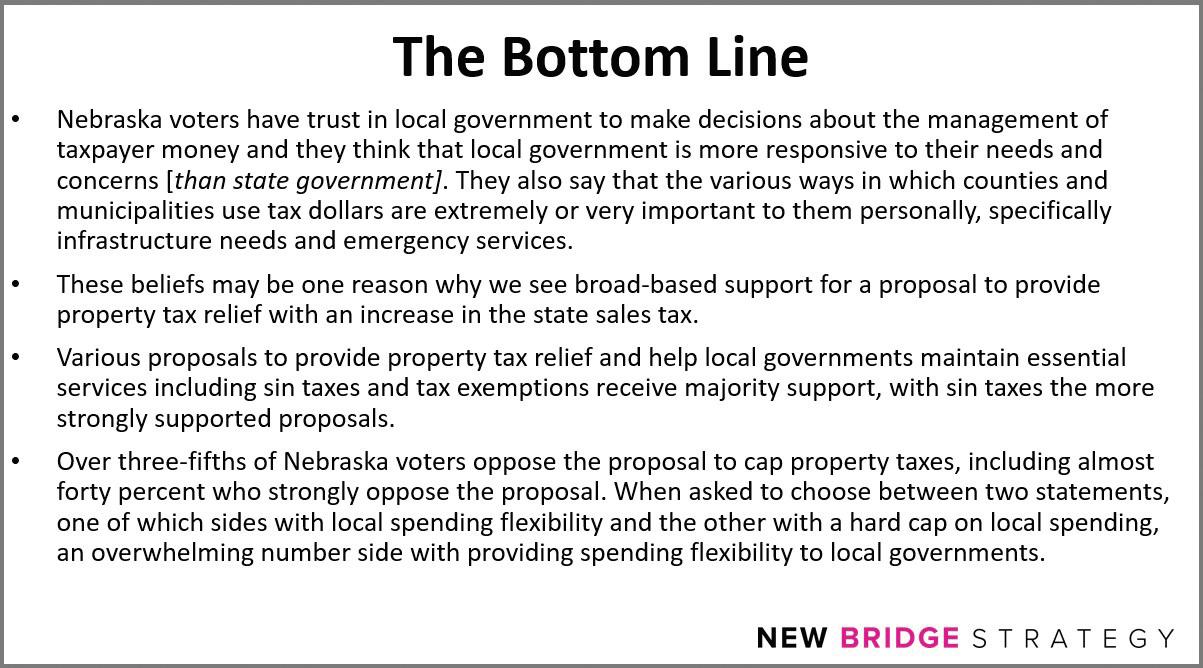
31 FEBRUARY 2024 Poll
the
on
5
from
Read the entire report at: https://bit.ly/49jG56y
Continued from
President’s Message
page
Below are excerpts
the New Bridge Strategy report: 2024 Nebraska Statewide Survey Key Findings - Feb. 2024
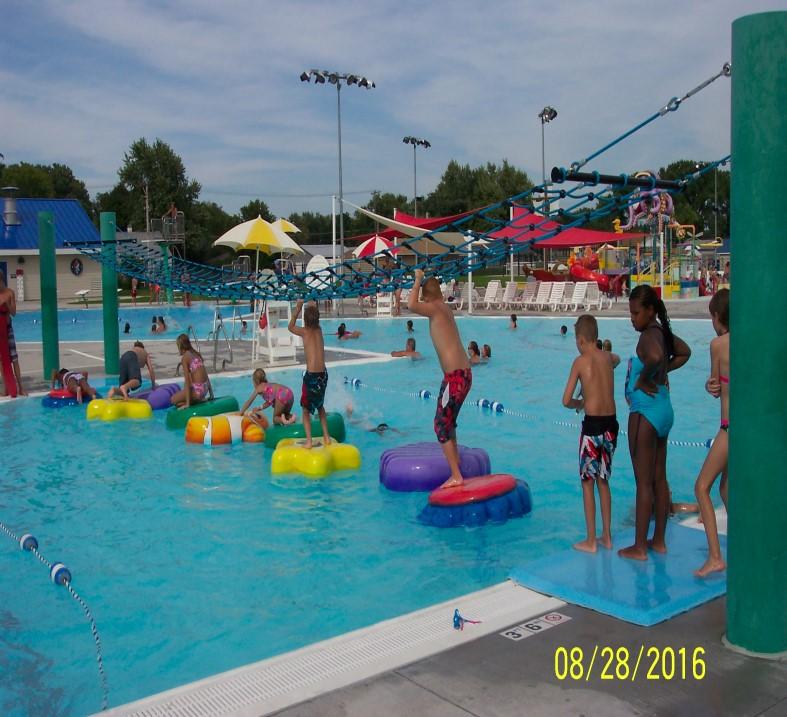

Pool leaks are problema�c and ignoring them creates much bigger problems. The nature of moving water is to expand its pathway gradually allowing a ever -greater volume to pass. This disparaging nature is an issue in itself. Especially when water is being purchased, treated, and heated, the financial loss increases rapidly.


Did your pool leak this swim season?
Do you have Structural Damage?
High Water Bill?
Excessive Chemical Use?
Dropping Water Levels?



32 NEBRASKA MUNICIPAL REVIEW www.burbachaqua�cs.com Burbach Aquatics, Inc. 5974 State Highway 80 South Platteville, Wisconsin 53818 Phone: 608-348-3262 Fax: 608-348-4970 Email: Support@Burbachinc.com BURBACH AQUATICS, INC.
YOU NEED TO GIVE BURBACH AQUATICS, INC. A CALL. PROVEN RELIABILITY IN AQUATIC DESIGN FOR OVER 45 YEARS!!
THEN
© 2023 BURBACH AQUATICS, INC.





































































 BY DAVE BOS, EXECUTIVE DIRECTOR, LARM
BY DAVE BOS, EXECUTIVE DIRECTOR, LARM







 Jeremiah J. Perkins
Jeremiah J. Perkins




















